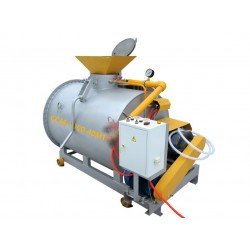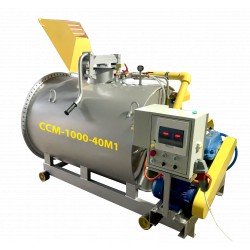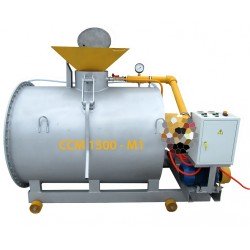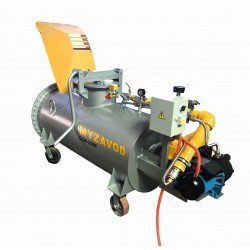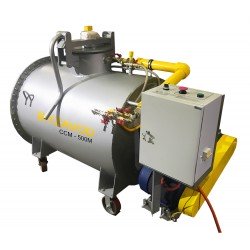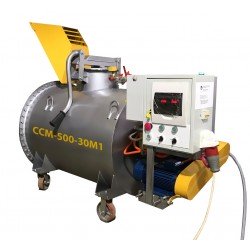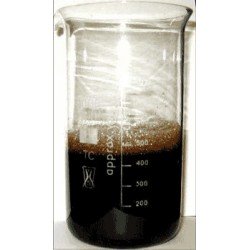Nowadays, new materials for construction are invented and produced, with various useful qualities. One of these inventions is foam concrete. To obtain foam concrete, a special substance is introduced into an aqueous solution of cement with sand - a foam concentrate, which forms a foam. When this mass solidifies, foam concrete is obtained. Individual blocks are produced either by cutting the total mass or by using special shapes.
Use of lightweight concrete
A mixture of foam concrete can be poured into block molds, so many entrepreneurs start their construction business selling the obtained foam blocks to various construction teams, individuals and construction points of sale. Also, foam concrete can be poured into the formwork for the monolithic construction of cottages and other residential and non-residential premises. Back in 1970 in the United Kingdom, foam concrete was used to build the Infill Tunnel, and at the same time, the Kent Thameside program built several blocks of foam concrete residential buildings for the public. Since then, the self-leveling and self-compacting properties of aerated concrete have proven their worth and aerated concrete has become increasingly popular with many engineers and contractors looking for an efficient, fast-producing, environmentally friendly and competitive building material. Today, foam blocks are used for the construction of various buildings, displacing such traditional materials as wood, brick and stone.
Benefits of lightweight concrete
Non-autoclaved lightweight concrete made on the basis of a protein foaming agent is one of the best building materials, due to the fact that houses made of foam blocks have the following advantages:
- Low thermal conductivity. Due to its porous structure, foam concrete perfectly retains heat inside the room. It is worth remembering that an increase in the density of the material reduces the thermal insulation properties;
- Soundproofing. Walls made of foam concrete can protect you from extraneous noise. This will save on special works on sound insulation;
- Walls made of foam blocks perfectly let air through. Houses made of this building material remain warm in winter and pleasantly cool in summer;
- Foam concrete - the material is environmentally friendly and does not harm human health;
- Foam concrete is resistant to temperature extremes, mechanical stress, non-flammable;
- In houses made of this material, a normal level of humidity is maintained. This protects the room from the appearance of mold, mildew and bacteria;
- It is very easy to work with foam blocks. They are lightweight and can be easily handled with hand tools.
All these advantages make foam concrete the cheapest material for construction. Ease allows you to build houses with less effort. There is no need to carry out additional work on thermal and sound insulation of the room.
Disadvantages of lightweight concrete
Along with the advantages, foam blocks have some disadvantages. Their strength is limited, so they are not suitable for the construction of buildings over ten meters high. It is necessary to carry out the external finishing of the building, since the foam concrete does not have a very aesthetic appearance. In addition, over time, the surface darkens and changes color. Exterior decoration will help protect the walls from the effects of precipitation. When transporting this material, consider its porosity to avoid damage.
Equipment for the production of lightweight concrete
For the production of foam concrete, the market today is rich in various special equipment, which can be divided into three classes:
- Equipment with a foam generator (classic technology);
- Punching equipment;
- Baroinstallations.
The production of lightweight concrete using classical technology allows the production of high-quality foam concrete of various density and strength. Such equipment has a high performance, has a relatively low cost, is simple and reliable. GC "My Plant" manufactures equipment for the production of foam concrete according to the classical technology, subject to the production regulations, we guarantee the production of non-autoclaved foam concrete according to the technical parameters corresponding to GOST 25485-89.
The slitting machine is suitable for the production of low density lightweight concrete. The porizator has a high productivity, however, the rather high cost of the entire porization complex is not always acceptable, especially when starting a business.
Baro-installations are equipment not intended for the production of environmentally friendly lightweight concrete, since all barotechnology is based on a synthetic foaming agent with the use of stabilizing additives, hardening accelerators, and other chemistry. Using this equipment, it is impossible to make lightweight heat-insulating foam concrete. The foam concrete itself made on the basis of pressure technology will be significantly inferior to the classic foam concrete in all properties.
Stages of construction of houses from lightweight concrete blocks
Drafting a project.
At this stage, the view of the future house is planned, the number and arrangement of rooms, placement of engineering communications. It is imperative at this stage to go through all the approvals for construction documents. In accordance with the project, all necessary materials are calculated and purchased.
Laying the foundation.
Most often, a monolithic or strip foundation is laid. It is imperative to ensure its waterproofing.
Wall masonry.
First, corner blocks are stacked to a height of 5–6 pieces. A special twine is pulled between them, along which the first row of the building is laid out. In the process of building walls, reinforcement is used.
Roof manufacturing.
Walls made of foam concrete are highly durable, so they can withstand a roof of any material. The roof must be carefully insulated and waterproofed.
Exterior decoration.
Foam concrete houses are finished with special plaster, facing bricks, siding or composite panels.
Interior decoration.
It is made using plaster, wooden lining or drywall. Houses from a foam block are becoming more and more popular due to their advantages. They are inexpensive, and the quality is not inferior to wooden and brick buildings.









